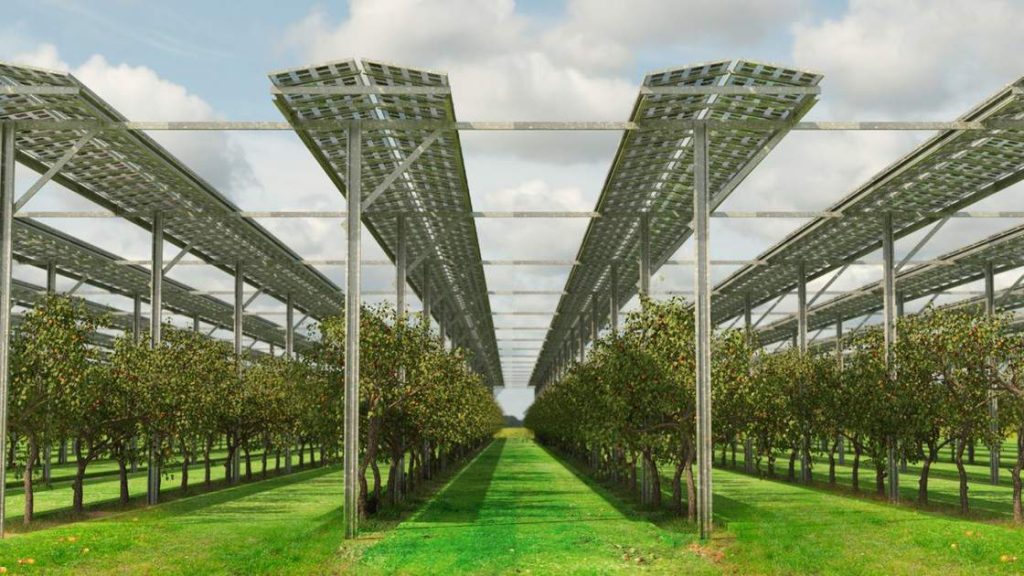Agri PV or Agrivoltaics consists on integrating PV modules above the crops in order to enhance climate resilience and allow sustainable food and energy production on one single piece of land. While in the past it was a question of either food or solar energy production on farmland, Agri PV can combine both successfully as well as achieving greater efficiencies on both activities.

By working together on the same land, farmers and energy developers can realize benefits for all involved while preserving the agricultural character of the state’s rural communities.
The growth of agrivoltaics is exponential and with that comes a great opportunity, but also a responsibility to develop and bring forward true agrivoltaic systems where the production of PV electricity is necessarily coupled to agricultural production.
In a recent article for Nature Sustainability, the U.S. Department of Energy’s National Renewable Energy Laboratory’s (NREL) Lead Energy-Water-Land Analyst Jordan Macknick and co-authors from the universities of Arizona and Maryland investigated the potential benefits of co-located agriculture and solar photovoltaic (PV) infrastructure (dubbed “agrivoltaics”) on food production, irrigation water requirements, and energy production.
Building Resilient Systems
Across the globe, reductions in precipitation and rising air temperatures are increasing vulnerabilities in both the agricultural and energy sectors. Water scarcity concerns are shaping conversations and driving action in the agricultural sector while extreme weather events are impacting energy systems worldwide, reducing the reliability of energy generation. As such, the resilience of the global energy system is of growing importance. Drought-proof technologies such as wind and solar photovoltaics can satisfy both resilience and sustainability concerns.
However, studies of ground-mounted PV installations with gravel groundcover have found increased temperatures surrounding solar arrays, creating a “heat island” effect. This is particularly problematic due to PV panel sensitivities to temperature increases and resulting consequences for performance.
The business-as-usual approach to PV installations is to employ gravel as ground cover. Swapping the gravel for vegetation via strategic planting can help counter the heat feedback loop.
Novel Ecosystems
Applying a model derived from low-impact urban design, researchers looked to the concept of “novel ecosystems,” and how they might benefit renewable energy and food production systems in dryland ecosystems. Researchers considered the possibility of co-located agriculture and solar PV infrastructure to maximize crop yields, minimize water use, and produce resilient, renewable energy.
To test their concept, researchers planted three common plants (chiltepin pepper, jalapeño, and cherry tomato), representative of three different dryland environments, beneath PV panels.
During the three-month growing season, they monitored light levels, air temperature, and relative humidity using sensors mounted above the soil surface. They also measured soil temperature and moisture at a depth of 5 centimeters. Both the control and agrivoltaic systems received the same irrigation in two testing scenarios: daily irrigation and irrigation every two days.
Implications for the Food-Energy-Water Nexus
While impacts varied by plant type, the researchers found that the agrivoltaic systems held promising implications for food production, water savings, and renewable energy production.
The reduction in direct sunlight exposure beneath the PV panels led to cooler air temperatures during the day and warmer temperatures at night, which allowed the plants under the solar arrays to retain more moisture than the control crops that grew in open-sky planting areas.
Results from in the study include:
Food production
- Total chiltepin fruit production was three times greater in the agrivoltaic system compared to the control
- Water-use efficiency for the jalapeño was 157% greater in the agrivoltaic system
- For the cherry tomato, water-use efficiency was 65% greater and total fruit production doubled in the agrivoltaic system
Water savings
- When irrigating every two days, soil moisture remained approximately 15% greater in the agrivoltaic system
- When irrigating daily, soil moisture in the agrivoltaic system remained 5% greater before the next watering
Improved renewable energy production
- Traditional ground-mounted PV panels were substantially warmer during the day than those with the plant-based understory
- The agrivoltaic PV panels were cooler during daytime hours compared to the traditional panel array by approximately 9°C, allowing for better performance.
The co-location of PV and agriculture could offer win-win outcomes across many sectors, increasing crop production, reducing water loss, and improving the efficiency of PV arrays. Adopting such synergistic paths forward can help build resilient food-production and energy-generation systems.
As Macknick notes, “The promising results of this work have broad implications for how solar development and farming across the globe could be integrated to provide mutual benefits.”



